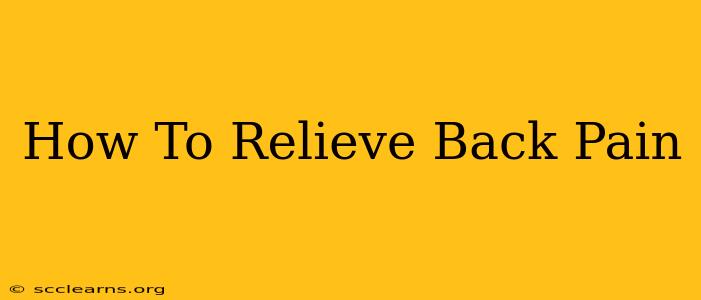Back pain is a common ailment affecting millions worldwide. Whether it's a sudden sharp pain or a persistent dull ache, back pain can significantly impact your daily life, limiting your mobility and overall well-being. This comprehensive guide explores various methods to relieve back pain, offering practical solutions and emphasizing the importance of prevention.
Understanding the Causes of Back Pain
Before diving into solutions, it's crucial to understand the potential causes of your back pain. While sometimes stemming from a specific injury like a muscle strain or herniated disc, back pain can also be attributed to:
- Poor Posture: Slouching, hunching over computers, and improper lifting techniques can put excessive strain on your spine.
- Lack of Exercise: Weak core muscles leave your back vulnerable to injury and pain.
- Excess Weight: Carrying extra weight puts added pressure on your spine.
- Stress: Muscle tension from stress can contribute to back pain.
- Underlying Medical Conditions: In some cases, back pain can indicate more serious conditions like arthritis, osteoporosis, or spinal stenosis.
Note: If your back pain is severe, persistent, or accompanied by other symptoms like numbness or weakness, seek professional medical advice immediately. This guide offers general advice and is not a substitute for medical diagnosis and treatment.
Effective Ways to Relieve Back Pain
Fortunately, many effective methods can help relieve back pain. These strategies can be used individually or in combination, depending on the severity and cause of your pain:
1. Over-the-Counter Pain Relief
Nonsteroidal anti-inflammatory drugs (NSAIDs) like ibuprofen or naproxen can help reduce inflammation and pain. Always follow the recommended dosage and consult a doctor if you have any concerns.
2. Heat and Ice Therapy
Applying heat or ice packs can provide temporary relief. Heat helps relax muscles, while ice reduces inflammation. Experiment to see which works best for you. Important: Never apply ice directly to the skin; use a towel as a barrier.
3. Rest and Stretching
While complete bed rest is generally discouraged, allowing your back to rest and avoiding strenuous activities is essential. Gentle stretching exercises can help improve flexibility and reduce muscle tension. Focus on stretches that target your back, hips, and hamstrings.
4. Core Strengthening Exercises
A strong core is crucial for supporting your back. Regular core strengthening exercises, such as planks, bridges, and abdominal crunches, can significantly reduce back pain. Start slowly and gradually increase the intensity and duration of your workouts.
5. Maintain Good Posture
Pay attention to your posture throughout the day. Sit upright with your back supported, avoid slouching, and maintain a neutral spine while standing. Consider using ergonomic furniture and adjusting your workstation to promote good posture.
6. Ergonomic Considerations
Evaluate your workspace and daily activities for potential ergonomic issues. Ensure your chair provides adequate lumbar support, your computer screen is at eye level, and you lift objects correctly using your legs and keeping your back straight.
7. Lifestyle Modifications
Making lifestyle changes can significantly impact your back health. Maintaining a healthy weight, quitting smoking (which reduces blood flow to the spine), and managing stress levels are crucial for long-term back pain relief.
Preventing Future Back Pain
Prevention is key to minimizing the risk of future back pain episodes. Here are some preventive measures:
- Maintain a Healthy Weight: Excess weight puts extra strain on your spine.
- Regular Exercise: Engage in regular physical activity that strengthens your core muscles and improves flexibility.
- Practice Good Posture: Be mindful of your posture at all times.
- Ergonomic Workplace: Ensure your workspace is ergonomically sound.
- Proper Lifting Techniques: Always lift objects correctly to avoid straining your back.
- Stress Management: Practice stress-reducing techniques such as yoga or meditation.
By understanding the causes of your back pain, implementing effective relief strategies, and adopting preventative measures, you can significantly improve your back health and overall well-being. Remember to consult with a healthcare professional for any persistent or severe back pain to rule out any underlying medical conditions and receive personalized treatment advice.

